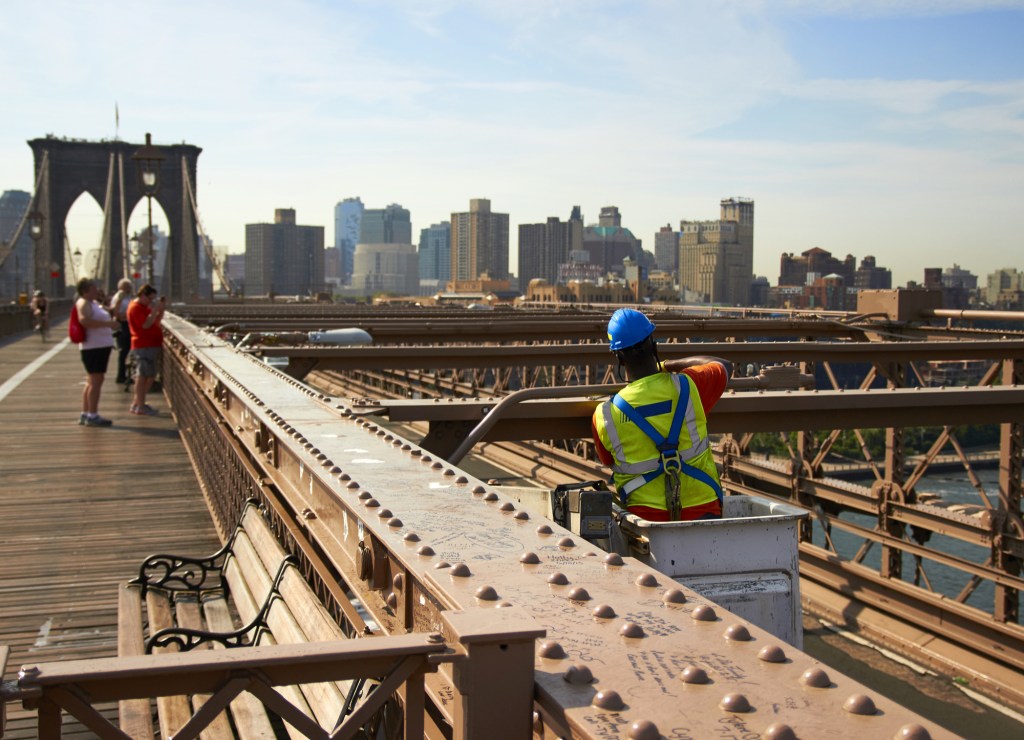When it opened in 1883, the Brooklyn Bridge was the answer to a geographical problem that should be familiar to anyone living in New York today: the jobs were in Manhattan but the cheap housing was in the outer borough. The solution was a very complicated one that tested the limits of engineering and technological ingenuity.
On paper, the suspension bridge to be constructed across the East River – an unprecedented distance – sounded veritably un-buildable. But that’s what drew John Roebling to the project: having earned a reputation as a designer of suspension bridges, he made his major breakthrough on the Brooklyn: a web truss made of steel, added to either side of the bridge roadway. This would make the bridge six times stronger than it needed to be. The mammoth project would consume him, literally – he died of tetanus after losing toes in a construction-related boat accident – and more than two dozen construction workers, who would die in falls and in a fire.
Videos by VICE
After Roebling’s 32-year-old son, Washington, took over as chief engineer, he himself ended up bedridden from compression sickness, the result of building the bridge’s two granite foundations inside timber caissons, or watertight chambers, which were sunk to depths of 44 feet on the Brooklyn side and 78 feet on the New York side. His partial paralysis led Roebling’s wife, Emily, to step in. She had studied higher mathematics, the calculations of catenary curves, materials strength, bridge specifications, and the intricacies of cable construction, and spent the next 11 years assisting her husband on the bridge’s construction.
One of the best testaments to the bridge’s strength has been its ability to withstand all the foot traffic that would follow subway suspensions during the blackouts of 1965, 1977 and 2003, or, most famously, after the September 11 attacks. That many people on a bridge – a contingency Roebling didn’t anticipate – can typically cause it to sway, due to self-reinforcing oscillations of many people walking in step. But in addition to its suspension system, the Brooklyn features a diagonal stay system and a stiffening truss. “The bridge may sag, but it will not fall,” the elder Roebling famously said.
Above: An Encyclopedia Britannica documentary on the Brooklyn Bridge.
At a cost of $15.5 million, 13 years, and 27 lives, the bridge opened to much fanfare on May 24, 1883 as the largest suspension bridge ever built. It was 50% longer than its predecessors, and immediately became an emblem of both the era’s optimism and its technological prowess. The project embodied a “literal and genuinely religious leap of faith”, John Perry Barlow, the Internet freedom pioneer writes. “The Brooklyn Bridge required of its builders faith in their ability to control technology.”
The bridge would itself help build one of the greatest American poems. Hart Crane’s1930 poem “The Bridge,” meant as a riposte to Eliot’s “dead” epic “The Waste Land,” praised the structure in an epic poem that sought “a more positive, or … ecstatic goal.”
O harp and altar, of the fury fused,
(How could mere toil align thy choiring strings!)
Terrific threshold of the prophet’s pledge,
Prayer of pariah, and the lover’s cry,—
Again the traffic lights that skim thy swift
Unfractioned idiom, immaculate sigh of stars,
Beading thy path—condense eternity:
And we have seen night lifted in thine arms.
Jack Kerouac and Marianne Moore were also inspired by the bridge, as was Walt Whitman, who wrote “Crossing Brooklyn Ferry” while the bridge was still under construction. The Russian Vladimir Mayakovsky may have written one of the most ecstatic tributes:
If the end of the world comes
and chaos smash our planet to bits,
and what remains will be this
bridge, rearing above the dust of destruction;
then, as huge ancient lizards are rebuilt
from bones finer then needles, to tower in museums,
so, from this bridge, a geologist of the centuries
will succeed in recreating our contemporary world.
He will say – that paw of steel
once joined the seas and the prairies;
from this spot, Europe rushed to the West,
scattering to the wind Indian feathers…
By the cables of electric strands,
I recognize the era succeeding the steam age –
here men had ranted on radio
Here men had ascended in planes.
For some, life here had no worries;
for others, it was a prolonged and hungry howl.
From this spot, jobless men
leapt headling into the Hudson…
The bridge’s suicides are estimated now to be in the hundreds—a metaphor maybe for other, darker themes in our technological history.
A few days after it opened, a dozen people were crushed to death during a stampede on the bridge – exacerbated by a false rumor that the bridge was going to collapse.
A much happier crossing is made every summer, when New York’s Poets House leads a pilgrimage across the bridge, featuring some of that poetry about those original twin towers.



